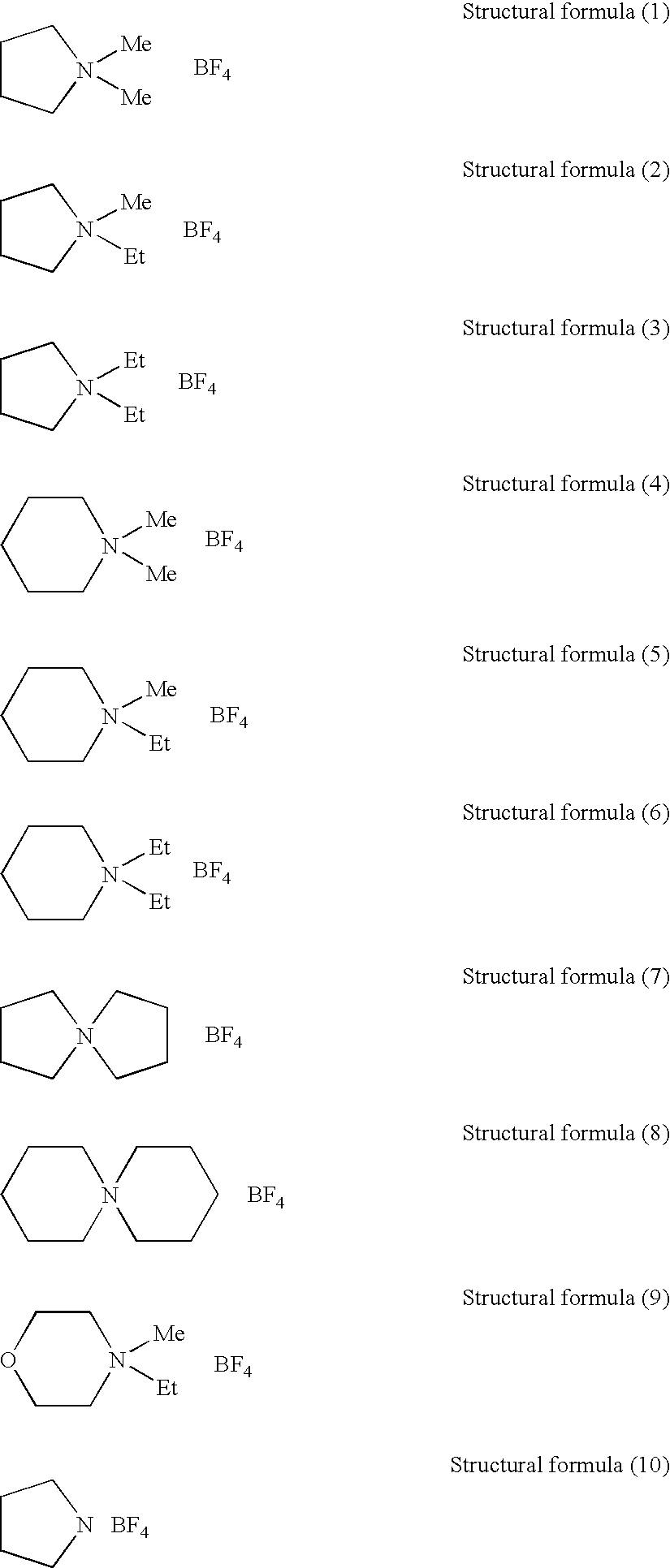Additive for non-aqueous liquid electrolyte, non-aqueous liquid electrolyte secondary cell and non-aqueous liquid electrolyte electric double layer capacitor
a technology of non-aqueous liquid electrolyte and additive, which is applied in the direction of secondary cells servicing/maintenance, non-aqueous electrolyte cells, cell components, etc., can solve the problems of negative electrode materials and water reacting, high danger of cell moltenness, and high safety. , good resistance to deterioration, good incombustibility
- Summary
- Abstract
- Description
- Claims
- Application Information
AI Technical Summary
Benefits of technology
Problems solved by technology
Method used
Image
Examples
example 1
[0162] [Preparation of a Non-Aqueous Electrolyte]
[0163] 10 ml (10 vol %) of a phosphazene derivative (a cyclic phosphazene derivative represented by formula (1) in which n is 3, 4R's are fluorine, and 2R's are fluorine-containing methoxy groups; fluorine content in the phosphazene derivative is 50 wt %)(an additive for a non-aqueous electrolyte) was added to 90 ml of a mixed solvent of diethyl carbonate and ethylene carbonate (mixture ratio (i.e., volume ratio): diethyl carbonate / ethylene carbonate=1 / 1) (aprotic organic solvent). Further, LiPF.sub.6 (supporting salt) was dissolved in this mixture at a concentration of 0.75 mol / kg, whereby a non-aqueous electrolyte (viscosity at 25.degree. C.: 4.2 mPa.multidot.s (4.2 cP); conductivity of 0.75 mol / l of a lithium salt dissolved solution: 6.5 mS / cm) was prepared.
[0164]
[0165] The obtained non-aqueous electrolyte was evaluated with respect to stability in the same manner as in the evaluation method of stability described later. Briefly, ...
example 2
[0182] Except that the amount of the mixed solvent of diethyl carbonate and ethylene carbonate was changed to 95 ml, and the amount of the phosphazene derivative was changed to 5 ml (5 vol %) in the "Preparation of a non-aqueous electrolyte" of Example 1, a non-aqueous electrolyte (viscosity at 25.degree. C.: 3.9 mPa.multidot.s (3.9 cP) was prepared in the same manner as that in Example 1, whereby incombustibility, flame retardancy, safety, and deterioration resistance were evaluated. Further, a non-aqueous electrolyte secondary cell was made in the same manner as that in Example 1, whereby initial cell characteristics (such as voltages and internal resistances), charging / discharging cycle performance, and low-temperature characteristics were respectively measured and evaluated. The results are shown in table 1.
example 3
[0183] Except that the amount of the mixed solvent of diethyl carbonate and ethylene carbonate was changed to 95 ml, the amount of the phosphazene derivative was changed to 5 ml (5 vol %), and LiBF.sub.4 (supporting salt) was replaced by LiPF.sub.6 (supporting salt) in the "Preparation of a non-aqueous electrolyte" of Example 1, a non-aqueous electrolyte (viscosity at 25.degree. C.: 3.9 mPa.multidot.s (3.9 cP) was prepared in the same manner as that in Example 1, whereby incombustibility, flame retardancy, safety, and deterioration resistance were evaluated. Further, a non-aqueous electrolyte secondary cell was made in the same manner as that in Example 1, whereby initial cell characteristics (such as voltages and internal resistances), charging / discharging cycle performance, and low-temperature characteristics were respectively measured and evaluated. The results are shown in table 1.
PUM
 Login to View More
Login to View More Abstract
Description
Claims
Application Information
 Login to View More
Login to View More - R&D
- Intellectual Property
- Life Sciences
- Materials
- Tech Scout
- Unparalleled Data Quality
- Higher Quality Content
- 60% Fewer Hallucinations
Browse by: Latest US Patents, China's latest patents, Technical Efficacy Thesaurus, Application Domain, Technology Topic, Popular Technical Reports.
© 2025 PatSnap. All rights reserved.Legal|Privacy policy|Modern Slavery Act Transparency Statement|Sitemap|About US| Contact US: help@patsnap.com

